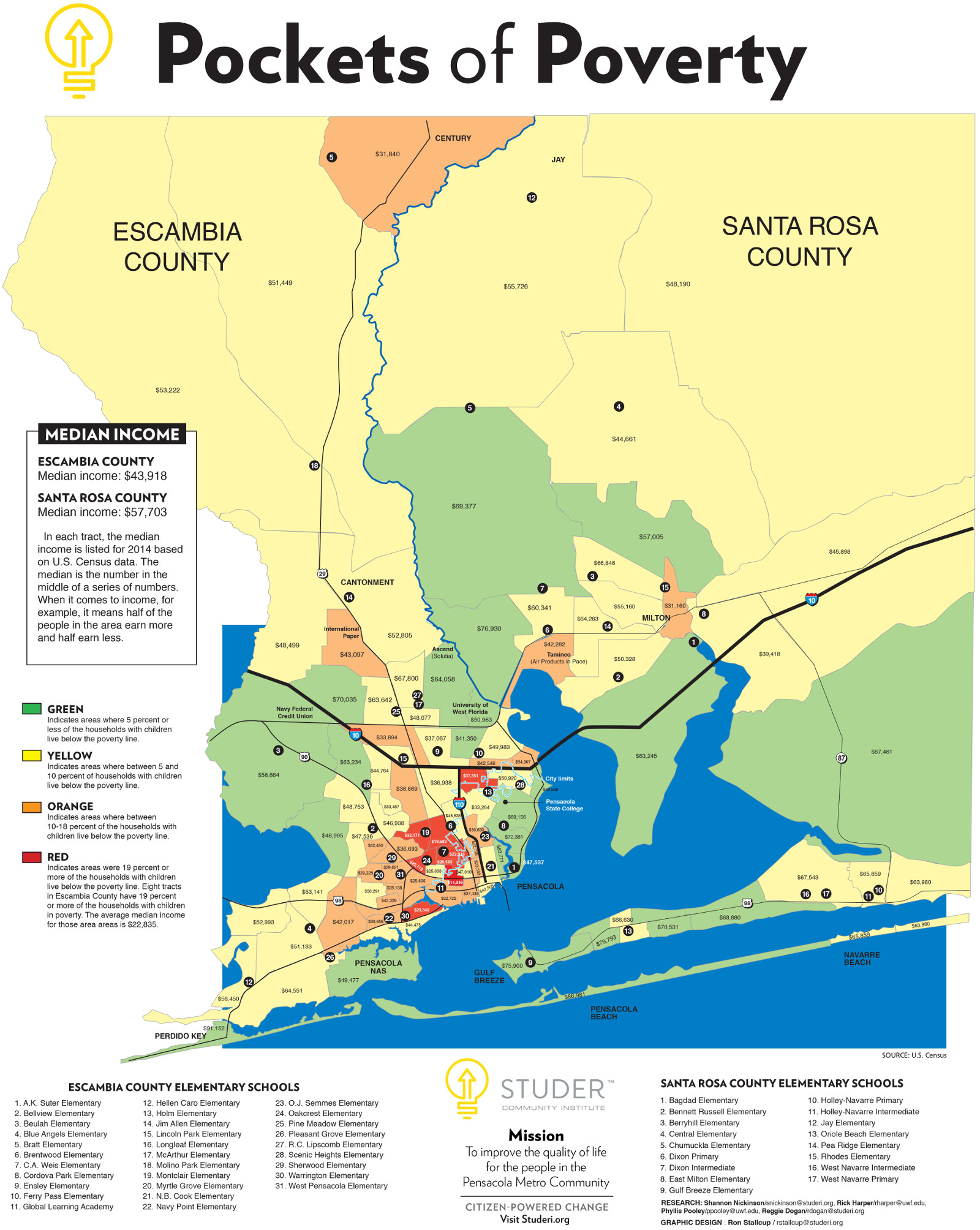
If an image is worth 1,000 words, the image below isn’t kind to Escambia County.
The map, built from U.S. Census Bureau data, highlights the pockets of poverty that hold back Escambia County.
New research by the Studer Community Institute and the University of West Florida has found that the poverty rate for households with children is 10 percent or higher in a third of the Census tracts in Escambia County.
Nearly 8,200 children under 5 years old live in those neighborhoods.
Among them is the neighborhood that Oakcrest Elementary School draws its students from, where the median income is $22,713 a year. All of Oakcrest’s students qualify for free school meals.
That’s where Peggie Bosso teaches one of six kindergarten classes at the school on Hollywood Avenue.
“At Oakcrest, you have to know that some of these babies are going to be way back here, and you’re just going to have to work super hard and get them where they need to be,” Bosso said.
Bosso’s classroom isn’t the only one where this is reality.
At 11 elementary schools where the free- and reduced-price lunch rate was above 85 percent, only one school earned a C on state standardized test metrics in 2014; the rest were D or F schools.
There are just 3,000 children under 5 years old in neighborhoods where the poverty rate for families is 5 percent or less.
Those neighborhood schools earned A’s or B’s on state standardized tests.
As those state standards demand more of children at a younger age, kindergarten is not the nurturing, play-centered environment that many adults remember.
“I’m teaching things in kindergarten that I taught first grade way back then,” said Bosso, who started her 24-year career as a first-grade teacher. “That curriculum’s been pushed down. A lot of times, in the first nine weeks we try to get our parents to come in just so we can sit down and show them the expectations.
“They’re just like, ‘Wow, OK.’ ”


Data from the Studer Institute’s dashboard shows that only 66 percent of Escambia 5-year-olds are ready for kindergarten, according to analysis by the Florida Office of Early Learning.
As the pace of what Bosso is expected to teach her students increases, the challenge grows for the ones who come to her without the basics.
“Five-year-olds are just eager. They want to learn,” she said. “But some of them don’t know how to hold a pencil. They don’t even recognize their name (when it’s written). I have kids that I have these little tracers for their name. They’re doing it for homework, they’re doing it in here.”
Targeting change efforts
The challenges Bosso sees in her classroom are repeated elsewhere.
The Institute’s recently updated Pensacola Metro Dashboard showed that 66 percent of the children in the Escambia County School District qualify for free or reduced-priced school meals. That’s about 26,400 of the district’s 40,000 students.
There are strategies under way to address the achievement gap.
Oakcrest has a community involvement coordinator, a job funded by Title I funds, money from the federal government allocated to schools with a high percentage of low-income students.

Leigh Ann South, who worked as community involvement coordinator at Oakcrest in 2013, now is part of a team that is leading the effort to turn C.A. Weis Elementary into a Community School. That effort is being led by the Children’s Home Society and includes grants and a mix of public and private funding.
The model makes schools a hub of community and social services to support students and their families. It has been implemented in schools since the early 1990s, beginning in New York City and spreading across the country to improve educational outcomes particularly in poor neighborhoods.
Rodney Ford is now Oakcrest’s community involvement coordinator; a job that past and current principals at the school agree has been crucial in helping Oakcrest’s families.
In his role, Ford has done everything from helping parents schedule appointments and getting students glasses to visiting a student’s home to make sure they get to school on time and helping parents fill out paperwork to get health insurance.
Superintendent Malcolm Thomas said that Oakcrest and Global Learning Academy are the only two elementary schools with a community involvement coordinator, but 28 elementary schools in the district are Title I schools.
Each school determines how to spend their Title I money, Thomas said. Each community involvement coordinator position costs about $50,000 including salary and benefits, Thomas said.
“Every child, every day, whatever it takes” is the Oakcrest motto. Bosso said the entire staff works hard to make that come to life for their families.
“That’s a hard thing, too,” Bosso said. “A lot of parents didn’t have a good school experience. We want them to know it’s OK, you’re welcome here any time you have questions. Please feel free. I feel like our whole staff has always been that way.”
But it can be a long road. And for teachers like Bosso, it sometimes means helping children who won’t get much help at home.
“Some parents are like, ‘let me have those sight word cards. We’re on it, we’re writing them three times. We’re doing the homework,’” Bosso said.
“Then there are those little babies who go home and you say, ‘Ask your mom to help you.’ They’re like, ‘I did. She won’t help me. She said no.’ What do you say?
“It’s just putting them that far back, and then they feel bad that their mom’s not going to help them. It breaks your heart, basically.”
For children who need extra help, Bosso uses strategies like small group work.
“They don’t have that concept of starting at the left-hand side and working your way to the right when they read,” she said. “They’re all over the page. It’s just basic things like that. It just seems like they’re so far behind, and trying to get them to catch up,” Bosso said.
“They know when they are behind and you just try to build them up, and say ‘No, no, it’s OK. We’re going to get this.’”
Resources: Census data for Escambia County. Census data for Santa Rosa County. Census tract map for Escambia County. Census tract map for Santa Rosa County.
Join Our Newsletter